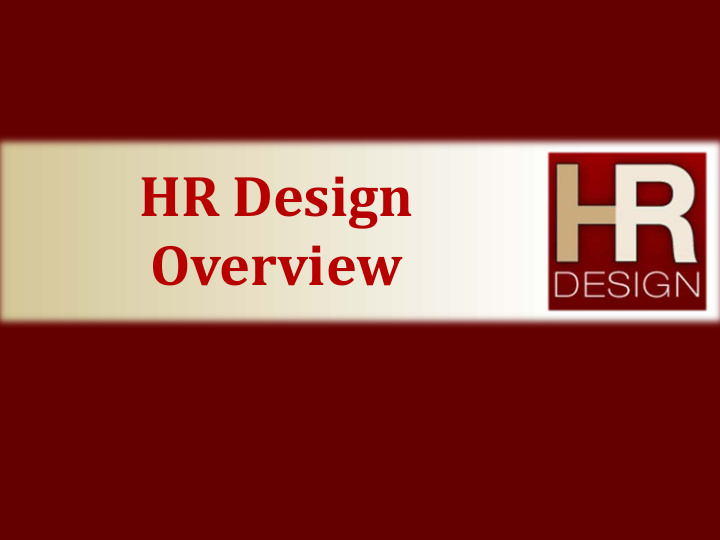



HR Design Overview
What is HR Design? HR Design is a campus-wide effort to build a more efficient and effective UW-Madison human resource system that best serves the needs of a 21st century public research university. The new system will place a premium on flexibility, responsiveness, consistency and transparency – to hire, develop and retain the right talent.
HR Design Vision 21 st Century University Vision Thoughtful Design Workforce and Community Efficient Diverse “A model public Each process, step or rule adds Create a community that draws university in the 21st value and can be accomplished in upon the ideas, experiences, a timely way century, serving as a and perspectives of a diverse resource to the public workforce and promotes an Flexible and Responsive and working to inclusive culture Processes can be adapted to a enhance the quality broad range of situations and Engaged of life in the state, allow for improvement Foster trust and commitment the nation, and the to employees; support their Aligned world.” development HR components integrated across employee lifecycle Right Talent Consistent Attract, develop and retain the Policies and processes are talent to sustain and continually common to as many employees improve a world-class university as possible unless required by a business need Adaptable Create a culture that fosters a Transparent shared ability to embrace and Processes driven by clearly respond to change communicated guidelines
Key HR Design Dates Dec. 2012 Jun. 2011 Board of April 23, 2014 2011-13 biennial Regents/UW budget provides governance Joint Committee on authority to create approves Employment new personnel HR Design Relations approves system Strategic Plan HR Design Sept. 2012 May 24, 2013 July 1, 2015 HR Design Joint Committee Begin Strategic Plan on Employment implementation of presented to Relations votes many elements of campus to delay aspects HR Design of HR Design until July 2015
HR Design Has Engaged Employees Campus-Wide HR Design Work Teams • Cross-campus work teams formed in 2012 to develop recommendations for new HR system • Teams included more than 150 members of the campus community Campus Engagement • HR Design planning and implementation has involved massive and ongoing campus engagement using multiple-audience focus groups, interactive web chats, quarterly campus-wide information sessions, surveys, polls, brochures and many other communications vehicles • Involved more than 15,000 participants to date
Critical HR Issues Balance workforce flexibility with Inconsistent employee job employee security / Perception of onboarding, protections hierarchy development and performance management Out-of-date job Two titles and personnel inflexible pay systems structures Need for Ineffective and new HR Limited data inefficient approach hiring 6
How HR Design Improves the Current State Challenge Approach Ineffective and inefficient recruitment • Provide new recruitment, assessment and selection tools tools and a new online applicant tracking system Out-of-date job titles and inflexible pay • Provide pay increases to those earning less than living structures wage • Incorporate market and performance into compensation • Revise job titles Inconsistent employee onboarding, • Implement campus-wide performance management and development and performance onboarding policies and provide training and resources, management including for managers and supervisors Need to balance workforce flexibility • Establish policies for University Staff that maintain job with employee job security protections and security Perception of hierarchy • Provide University Staff with governance Two separate personnel systems • Create greater consistency in policies and practices Limited data to inform decisions • Implement systems that will better inform recruiting, hiring, and other employment-related decisions
Key Takeaways – July 1, 2015 Unit-specific recruitment More compensation flexibility for faculty and staff Performance management campus-wide Comprehensive new employee onboarding to help new employees acclimate New policies balance management flexibility with employee protections Salaried classified positions moving to academic staff Standard HR competencies Workforce flexibilities explained and promoted Expanded training for managers and supervisors
Recommend
More recommend